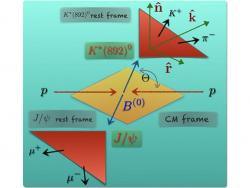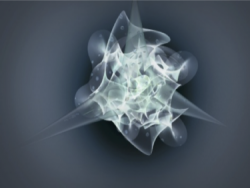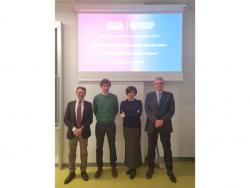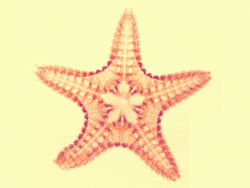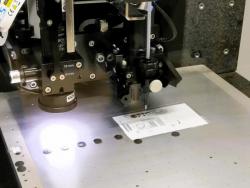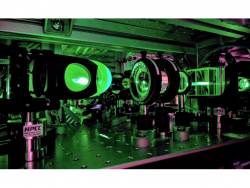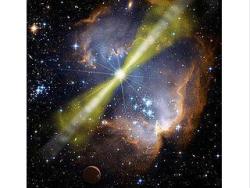- Home
- Department
- Research
- Teaching
- Post Graduate Studies
- Knowledge Transfer
- How To
Nucleon Spin Structure: COMPASS at CERN
Research Strand:
to be updated (see ![]() )
)
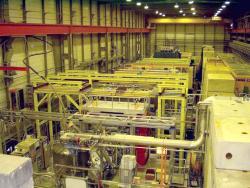 The aim of the COMPASS experiment is to investigate hadron structure and hadron spectroscopy, both manifestations of non-perturbative quantum chromodynamics (QCD), which has yet to satisfactorily describe all known phenomena. More specifically, forty years after the invention of the quark model, fundamental questions like: “How is the proton spin carried by its constituents?” and “Do exotics, non q-qbar mesons, or non qqq baryons actually exist?” still await a clear answer.
The aim of the COMPASS experiment is to investigate hadron structure and hadron spectroscopy, both manifestations of non-perturbative quantum chromodynamics (QCD), which has yet to satisfactorily describe all known phenomena. More specifically, forty years after the invention of the quark model, fundamental questions like: “How is the proton spin carried by its constituents?” and “Do exotics, non q-qbar mesons, or non qqq baryons actually exist?” still await a clear answer.
COMPASS (Common Muon and Proton Apparatus for Structure and Spectroscopy) is a fixed-target experiment at CERN, set up by an international collaboration of 31 Institutes made up of 250 physicists from 11 different countries. Taking advantage of the large integrated luminosities of the 450 GeV proton beam accelerated from the SPS, which is then used to produce secondary beams of different types of particles with energies varying from 100 GeV to a few hundred GeV, COMPASS can perform a wide programme of physics measurements of unprecedented statisical accuracy. In particular, high-intensity hadron and muon beams are used to study hadron spectroscopy and nucleon structure respectively.
As regards hadron spectroscopy, one of the main aims of the experiment is to find an answer to the long-standing question of exotic states, which are foreseen by QCD but whose actual existence has still to be proven. COMPASS has already published evidence for an exotic state with quantum numbers JPC=1-+and mass 1.66 GeV/c2, and the analysis of the huge amount of data collected in 2008 and 2009 is still ongoing: the results are expected to finally provide clear answers as to whether exotic states exist or not.
The measurements of the pion and kaon polarizabilities via Primakoff scattering in order to test the predictions of the chiral perturbation theory, the low energy limit of QCD, is an other important field of research in COMPASS. The results on the pion polarisability have been published very recently. For its relevance the measurement has been the object of an official CERN Press Release, "CERN experiment brings precision to a cornerstone of particle physics", 11 February 2015, in which the Director General said "This result is admirably complementary to the studies of fundamental interactions performed at the LHC and a testimony to the diversity and strength of CERN’s research programme."
With regard to the spin structure of the nucleon, a major aim of the experiment was to measure gluon polarization in a longitudinally polarized nucleon. After the fundamental discovery in 1988 (then confirmed in numerous experiments in the 1990s) that proton spin is only partly accounted for by quark spin, direct measurement of gluon polarisation had become a priority. Using the data already collected in 2002 with a 160 GeV longitudinally-polarised muon beam and deuteron target, COMPASS was the first experiment to find convincing evidence that the gluon contribution to nucleon spin is small, and not enough to supply the "missing part". In parallel, and soon after these measurements, COMPASS measured SIDIS processes with polarized targets which make it possible to measure the spin-dependent parton distribution functions by comparing the spin asymmetries measured with proton and deuteron targets and identifying the final state hadrons. Hadron identification in COMPASS is based on a ring-imaging Cerenkov counter (RICH) built and operated by the Trieste group. Of particular importance is the study of the quark's transverse spin distribution functions (the “transversity” distributions), whose importance has only recently been recognized. The SIDIS measurements with transversely polarised deuteron and proton targets carried out by COMPASS in the years 2002, 2003, 2004, 2007 and 2010, together with the HERMES and Belle measurements, have shown that transversity is different from zero and measurable in SIDIS processes. Using the same data, COMPASS and HERMES have also measured clear signals for different transverse spin effects, which can be explained in terms of newly-introduced transverse momentum dependent (TMD) distribution functions, such as the Sivers function.
After the CERN accelerators shutdown, COMPASS has started again the data taking to perform in the years 2015-2017 two new measurements:
1) measurement of the Drell-Yan process in pion - transversely polarized proton interaction (2015). This measurement will make it possible to test a most important prediction of QCD, namely the fact that a T-odd parton distribution like the Sivers function has the opposite sign when measured in a Drell-Yan reaction rahter then in SIDIS because of initial/final state interactions.
2) measurement of generalized parton distributions (GPDs) by means of the deeply virtual Compton scattering reaction on a liquid hydrogen target (2016-2017). These measurements will provide information on the angular momentum carried by the quarks in a proton, the missing ingredient in the spin decomposition of a longitudinally polarized proton. In parallel precise SIDIS data will be collected.
The Trieste group is presently involved in several activities: detector developement and upgrade, data processing and analysis, studies and planning of new measurements, phenomenological interpretation of the data in collaboration with theoretical physicists, and managment. In particular Andrea Bressan is presently co-spokesperson of the experiment.
Info
Last update: 09-11-2024 - 07:45


